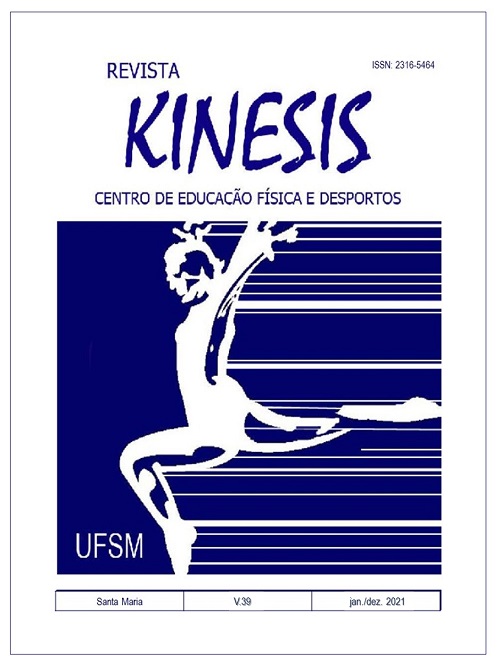Netnography of swimming/aquatic body practices in school physical education
DOI:
https://doi.org/10.5902/2316546464961Keywords:
Swimming, Aquatic body practices, CyberspaceAbstract
This research sought to answer the following question: how are aquatic body practices and swimming, in particular, as educational content in school physical education disseminated in cyberspace on social networks? Its objective is to discuss and analyze, based on netnography, the place of aquatic/swimming body practices in the context of school physical education. To this end, a netnography was carried out on the social networks Facebook.com, Instagram.com, Twitter.com, Linkedin.com and Youtube.com. The results point to an incipient context regarding the teaching-learning process involving swimming aquatic practices in the school environment and disseminated in the cyberspace. However, there is the spread of teaching this subject from the routines of pedagogical sequences composed of contents that prioritize the technical gestural domain of the four classic swims. There is also a prevalence of teaching this content in the daily lives of private schools, however in the format of coaching and as extracurricular advertising.Downloads
References
BRACHT, V. Educação Física & Ciência: cenas de um casamento (in)feliz. 2. ed. Ijuí, RS: Unijuí, 2003.
BRASIL. Secretaria de Educação Fundamental. Parâmetros Curriculares Nacionais. Educação Física, 1o e 2o ciclos, v.7, Brasília: MEC, 1997.
BRASIL. Ministério da Educação. Base nacional comum curricular. Terceira Versão. Brasília: MEC, 2019.
CARLAN, P.; DÜRKS, D. B. O conteúdo “atividades aquáticas” na educação física escolar: limites e perspectivas. Revista Kinesis, Santa Maria v.36, n.3, p. 2–14, set-dez. 2018.
CATTEAU, R. e GAROFF, G. O ensino da natação. 3 ed. São Paulo: Manole, 1990.
FERNANDES, J. R. P.; LOBO DA COSTA, P. H. Pedagogia da natação: um mergulho para além dos quatro estilos. Revista Brasileira de Educação Física e Esportes. São Paulo, jan./ mar. 2006, v. 20, n° 1, pp. 5-14.
GRUPO DE TRABALHO PEDAGÓGICO UFP/UFSM. Visão Didática da Educação Física: análise críticas e exemplos práticos de aula. Rio de Janeiro: ao livro técnico, 1991.
GALATTI, L.R., PAES, R.R. Fundamentos da Pedagogia do Esporte no Cenário Escolar. Revista Movimento e Percepção, Espírito Santo do Pinhal Vol. 6, Nº 9, p.16-25, jul.-dez.,2006.
KOZINETS, R. V. Netnografia: realizando pesquisa etnográfica online. Porto Alegre: Penso, 2014.
LEVY, P. Cibercultura. São Paulo: Ed. 34, 1999.
MACEDO, N. P. et al. Natação: o cenário no ciclo 1 do ensino fundamental nas escolas particulares. Revista Mackenzie de Educação Física e Esporte,v. 6, n. 1 , 2007.
MARSIGLIA, A. C. G., MARTINS, L. M.; LAVOURA, T. N. Rumo à outra didática histórico-crítica: superando imediatismos, logicismos formais e outros reducionismos do método dialético. Revista HISTEDBR On-Line, 19, e019003, 2019.
REVERDITO, Riller Silva et al. Competições escolares: reflexão e ação em pedagogia do esporte para fazer a diferença na escola. Pensar a prática, v. 11, n. 1, p. 37-45, 2008.
SOUZA, R., T. A. e SILVA, M S. Atividades Aquáticas diferenciadas nas aulas de Educação Física In: Os desafios da escola pública paranaense na perspectiva do professor PDE artigos. Volume 1.. Cadernos PDE. Paraná. Governo do Estado. Secretaria de Educação, 2013.
SOARES, C. et al. Metodologia do ensino da educação física. São Paulo: Cortez, 1992.
SOARES, C. et al. Metodologia do ensino da educação física. São Paulo: Cortez, 2012.
Downloads
Published
How to Cite
Issue
Section
License
The works must be submitted in the digital format of the SEER platform, via the electronic address: http://periodicos.ufsm.br/kinesis/index. In case of any doubts, contact the editorial team through the email kinesisrevista@ufsm.br. The authorship that publishes in the Kinesis journal agrees to the following terms:
- They retain copyright and grant the journal the right of first publication.
- They allow and are encouraged to publish and disseminate their work online (e.g., in institutional repositories or on their personal page) as this can cause positive alterations, as well as increase the impact and quotation of the published work.







